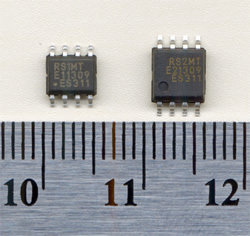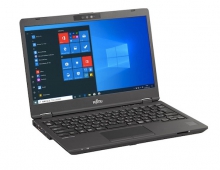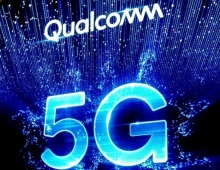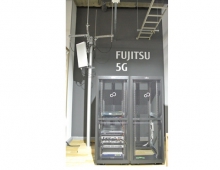
Fujitsu Releases New 1 Mbit and 2 Mbit FRAM
Fujitsu Semiconductor Limited today announced the development of two new FRAM products, MB85RS1MT and MB85RS2MT, which feature 1 Mbit and 2 Mbit of memory, respectively.
Fujitsu will be offring the new products in sample quantities starting end of March 2013.
 The two new FRAM products guarantee 10 trillion read/write cycles, roughly ten times more than existing chips, making them optimal for use in applications such as smart meters, industrial machinery and medical devices. Fujitsu claims that compared to identical density EEPROM, MB85RS1MT and MB85RS2MT consume 92% less power during writing. In addition, because the new FRAM products can incorporate all the technology required for system memory components - which have typically consisted of EEPROM, SRAM and a battery for data retention - into a single chip, it is possible to substantially reduce component costs, mounted area, and power consumption. This, in turn, will also contribute to the development of smaller, power-efficient equipment for which maintenance can be easily performed, since backup battery is not necessary.
The two new FRAM products guarantee 10 trillion read/write cycles, roughly ten times more than existing chips, making them optimal for use in applications such as smart meters, industrial machinery and medical devices. Fujitsu claims that compared to identical density EEPROM, MB85RS1MT and MB85RS2MT consume 92% less power during writing. In addition, because the new FRAM products can incorporate all the technology required for system memory components - which have typically consisted of EEPROM, SRAM and a battery for data retention - into a single chip, it is possible to substantially reduce component costs, mounted area, and power consumption. This, in turn, will also contribute to the development of smaller, power-efficient equipment for which maintenance can be easily performed, since backup battery is not necessary.
FRAM is a type of memory that features both non-volatility, which allows data to be retained even when the power is switched off, and random access, which enables fast data writing. Because FRAM can safely store data that is being written even at sudden power source failures and power outages, it is possible to ensure the protection of equipment information and data recorded immediately preceding a power source outage.
For applications including smart meters and other measurement devices, as well as industrial machinery and medical devices such as hearing aids?all of which to date have required 1-2 Mbit non-volatile memory with a serial interface?it is now possible to replace conventional EEPROM with Fujitsu Semiconductor's new FRAM products. The resulting improvements in fast writing can lead to greater performance, while also minimizing the risk of data loss from sudden voltage drops or power outages. In terms of power consumed during writing, as well, the new products consume 92% less power than EEPROM, thereby helping to extend battery life.
Moreover, for industrial machinery that employs SRAM for data recording and EEPROM for storing parameters and programs, the new FRAM products can incorporate these capabilities into a single chip, allowing for a reduction in the number of memory components required and obviating the need for batteries for data retention. The memory itself can also be shrunk into a smaller package size, making it possible to reduce the mounted area required for memory components by over 90%.
 The two new FRAM products guarantee 10 trillion read/write cycles, roughly ten times more than existing chips, making them optimal for use in applications such as smart meters, industrial machinery and medical devices. Fujitsu claims that compared to identical density EEPROM, MB85RS1MT and MB85RS2MT consume 92% less power during writing. In addition, because the new FRAM products can incorporate all the technology required for system memory components - which have typically consisted of EEPROM, SRAM and a battery for data retention - into a single chip, it is possible to substantially reduce component costs, mounted area, and power consumption. This, in turn, will also contribute to the development of smaller, power-efficient equipment for which maintenance can be easily performed, since backup battery is not necessary.
The two new FRAM products guarantee 10 trillion read/write cycles, roughly ten times more than existing chips, making them optimal for use in applications such as smart meters, industrial machinery and medical devices. Fujitsu claims that compared to identical density EEPROM, MB85RS1MT and MB85RS2MT consume 92% less power during writing. In addition, because the new FRAM products can incorporate all the technology required for system memory components - which have typically consisted of EEPROM, SRAM and a battery for data retention - into a single chip, it is possible to substantially reduce component costs, mounted area, and power consumption. This, in turn, will also contribute to the development of smaller, power-efficient equipment for which maintenance can be easily performed, since backup battery is not necessary.
FRAM is a type of memory that features both non-volatility, which allows data to be retained even when the power is switched off, and random access, which enables fast data writing. Because FRAM can safely store data that is being written even at sudden power source failures and power outages, it is possible to ensure the protection of equipment information and data recorded immediately preceding a power source outage.
For applications including smart meters and other measurement devices, as well as industrial machinery and medical devices such as hearing aids?all of which to date have required 1-2 Mbit non-volatile memory with a serial interface?it is now possible to replace conventional EEPROM with Fujitsu Semiconductor's new FRAM products. The resulting improvements in fast writing can lead to greater performance, while also minimizing the risk of data loss from sudden voltage drops or power outages. In terms of power consumed during writing, as well, the new products consume 92% less power than EEPROM, thereby helping to extend battery life.
Moreover, for industrial machinery that employs SRAM for data recording and EEPROM for storing parameters and programs, the new FRAM products can incorporate these capabilities into a single chip, allowing for a reduction in the number of memory components required and obviating the need for batteries for data retention. The memory itself can also be shrunk into a smaller package size, making it possible to reduce the mounted area required for memory components by over 90%.





















